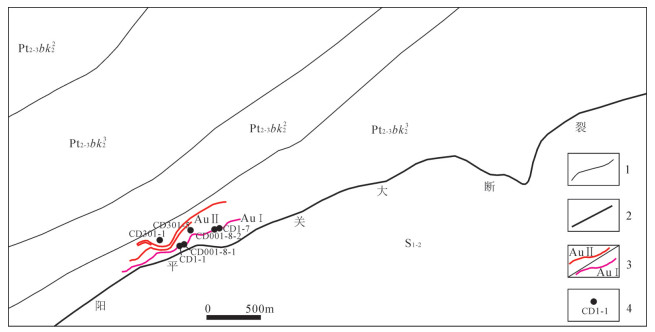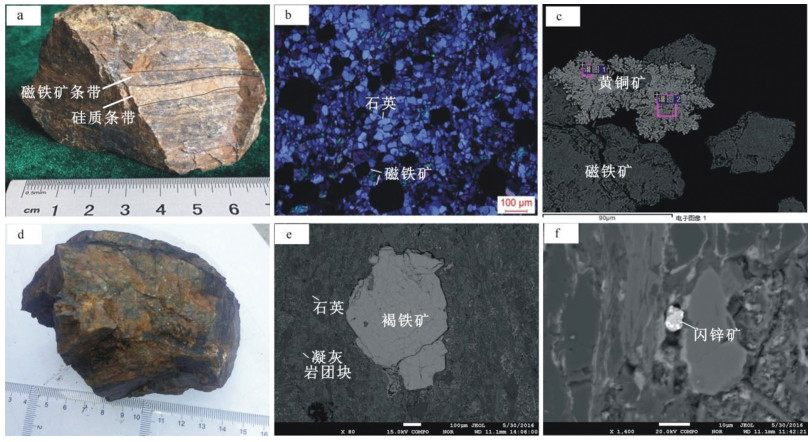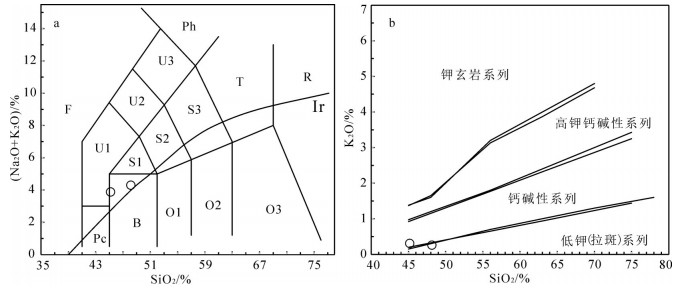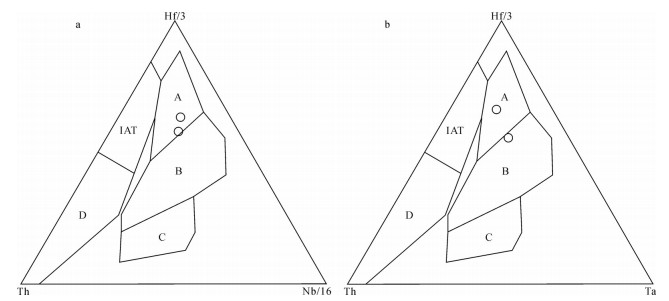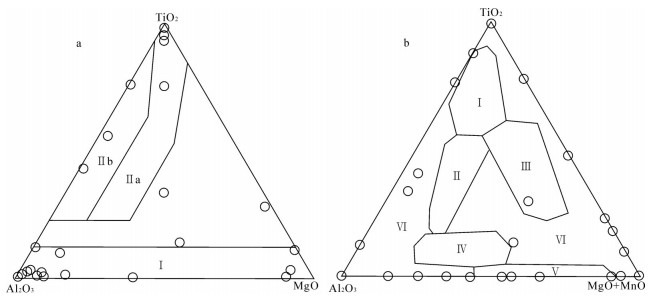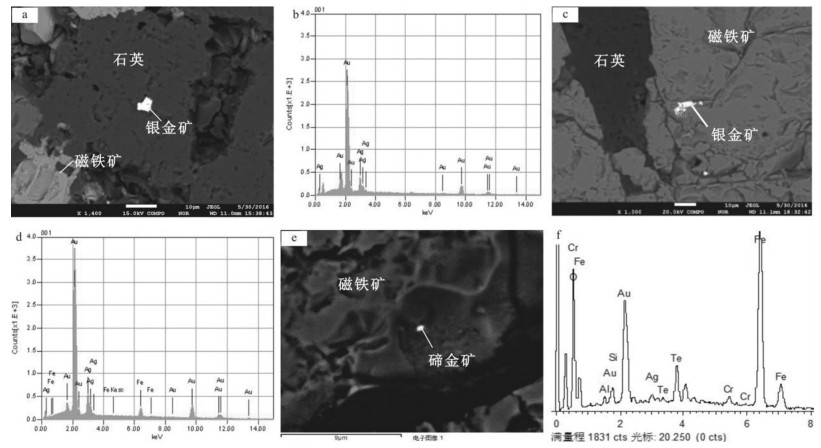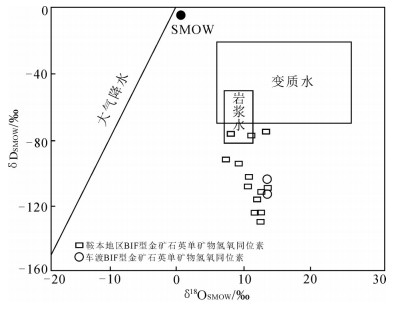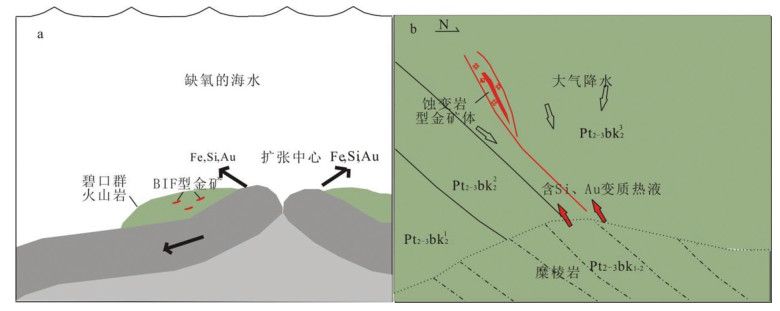The genesis of the Chedu gold deposit in Nansha River area, Shaanxi Province
-
摘要:
针对陕西南沙河地区车渡金矿床进行了研究,研究结果表明,中-新元古界碧口群二亚群(Pt2-3bk2)中玄武质火山凝灰岩具Sr、Ba、Rb、Ce、P、Sm相对富集,Ta、Nb、Zr、Hf、Ti相对亏损的特征,显示钙碱性火山弧玄武岩的特点;车渡金矿床具有2种成因类型,一是与中生代逆冲推覆构造形成的韧性剪切带有关的强硅化蚀变岩型金矿,二是与中-新元古界碧口岩群二亚群火山凝灰岩有关的BIF型金矿。单颗粒磁铁矿成分分析认为,车渡含金磁铁石英岩中磁铁矿具有高的TFeO(平均值99.59%)含量和极低的TiO2、MgO、A12O3、MnO含量,指示车渡磁铁石英岩金矿石中条带状磁铁矿属于沉积变质型成因条带状含铁建造。含金磁铁石英岩型金矿石的氢氧同位素显示,δ18O水值为12.34‰~12.45‰(平均值12.40‰),δD值为-112.6‰~-103.5‰(平均值-108.05‰),与鞍山-本溪地区条带状含铁建造型铁矿δD变化范围(-129‰~-75‰)一致,暗示车渡含金磁铁石英岩中石英矿物具有条带状含铁建造特征。
Abstract:In this paper, the research work of the Proterozoic deposit in Nansha River area of Shaanxi Province was carried out, and the results show that the basalt volcanic tuff in Bikou Group 2nd sub-group (Pt2-3bk2) is relatively rich in Sr, Ba, Rb, Ce, P and Sm, and depleted in Ta, Nb, Zr, Hf and Ti, exhibiting characteristics of calcium-alkaline volcanic arc basalt. There are two genetic types of the Proterozoic deposits, one is the strongly silicified rock type gold deposits related to the ductile shear zone formed by the Mesozoic thrust Nappe structure, and the other is the BIF type gold deposits related to the 2nd subgroup volcanic tuff of the Meso-Neo Proterozoic period. According to composition analysis of single granular magnetite, the authors hold that magnetite has high TFeO (99.59% on average) content and very low TiO2, MgO, A12O3 and MnO content in gold magnetic quartz, which indicates that the banded magnetite in the Chedu magnetite quartzite gold ore is of sedimentary metamorphic type, i.e., belonging to quartzite type gold deposit. Hydrogen and oxygen isotope features of gold-bearing magnetite quartzite type gold ore show that δ18O water value is 12.34‰~12.45‰ (12.4‰ on average), and δD value is -112.6‰~-103.5‰ (-108.05‰ on average), consistent with BIF variation range of δD-type iron ore in Anshan-Benxi area (-129‰~-75‰), suggesting that quartz minerals in quartz rocks with gold magnetite have BIF characteristics.
-
胶东位于华北克拉通东南缘,是中国最大、最古老的克拉通(2.5~3.8 Ga)[1],已探明黄金总储量超过5000 t[2-3]。胶东金矿主要赋存于中生代花岗岩类岩石中[4-6],胶东金矿省是世界知名的花岗岩类金矿省[7]。花岗岩类岩石在胶西北分布面积大于50%,侵入前寒武纪基底岩,经历了角闪岩-花岗岩相变质作用[8]。胶东金矿主要划分为焦家式、玲珑式和蓬家夼式3种矿化类型,均为断层控矿[9-11]。
以往关于胶东金矿床的研究多集中于金矿床的地质特征、成矿年龄、成矿流体特征,以及成矿物质来源、地球动力学机制等[2-4,9-14],多数研究介绍了不同类型金矿床的蚀变矿化组合的矿物学特征、空间分带关系等[7-8, 15-17], 但对与金矿化有关的围岩蚀变的综合研究相对较少。本文以典型焦家式金矿床为研究对象,系统讨论金矿化与热液蚀变作用过程的关系。
三山岛北海域金矿床(简称海域金矿)是在三山岛金矿北部海域隐伏区发现的超大型金矿,位于三山岛-仓上断裂(简称为三仓断裂)带北段,是典型的破碎带蚀变岩型金矿床[6]。对海域金矿的研究主要集中在矿床地质特征、控矿构造、构造-岩浆背景等方面[6, 18-20]。该矿床金矿体主要赋存于沿三仓断裂带发育的热液蚀变带中,对与金成矿作用有关的热液蚀变作用研究较少。在该地区开展了系统的勘探工作,钻孔岩心保存完好,可为矿床地质特征、热液蚀变研究等提供重要标本。本文系统描述了海域金矿床的金矿化与热液蚀变矿物组合,以及两者的空间分带特征及其共生组合关系、岩石地球化学组成、流体包裹体成分及温压条件等,讨论金矿化与热液蚀变有关的元素活动性、含金成矿流体性质和热液蚀变作用过程。
1. 区域地质背景
华北克拉通主要由燕辽、鄂尔多斯和阴山3个主要地壳块体组成[21],经历了多个旋回从陆核成长为陆台[22]。胶东金矿省位于华北克拉通东南缘(图 1-a),以烟台-五莲断裂为界,分为东部的鲁东地体和西北的胶北地体(图 1-b)。几乎所有金矿床都赋存于胶北地体[12],其中,超过80%的金矿化赋存于玲珑式花岗岩中(图 1-b)。胶北地体包括前寒武纪变质基底和中生代花岗岩类岩石。前寒武纪变质基底主要由太古宙胶东群、古元古代荆山群、粉子山群和新元古代蓬莱群变质岩系组成[1, 23-24]。中生代花岗岩类主要发育于侏罗世和早白垩世2个岩浆活动时期,侏罗系岩浆活动以晚侏罗世(160~150 Ma)陆源玲珑式黑云母花岗岩和栾家河式二长花岗岩类为代表[25-27];早白垩世岩浆活动包括郭家岭型-花岗闪长岩(130~126 Ma)、斑状二长花岗岩(118~110 Ma)、胶莱盆地的镁铁质-长英质火山岩(110~130 Ma)及广泛分布的镁铁质岩脉(122~124 Ma)[27-30]。胶东在中生代主要经历了2个变形阶段:一是NW—SE斜向挤压,可能与Izanagi-太平洋板块的俯冲有关[8, 26],使NNE向和NE向脆性韧性剪切带发生了明显的左旋反向运动;二是NE向和NW向的伸展脆性构造和半地堑盆地的发育,并伴有金矿化和基性岩脉侵入,这些构造通常被认为是郯庐断裂的次级构造[9-10]。
2. 矿床地质特征
海域金矿位于胶东大型金矿集区西北部胶北地体西侧的三山岛-仓上断裂(SCF)带北段(图 1-b、图 2-a),距莱州市约20 km;该矿床已探明金储量470 t,平均品位4.30 g/t[6]。NE向的三山岛-仓上断裂带(F1),倾向SE、倾角40°~50°、长超过12 km、宽20~400 m,控制了仓上、新立、三山岛、海域4个主要矿床的产出,总储量已超过1100 t[6, 31-33]。
![]() 图 2 三山岛-仓上断裂带区域地质简图(a)和三山岛北海域金矿床地质简图(b)[18]Figure 2. Simplified regional geological map of the SCF (a) and the simplified geological map of the Haiyu gold deposit(b)
图 2 三山岛-仓上断裂带区域地质简图(a)和三山岛北海域金矿床地质简图(b)[18]Figure 2. Simplified regional geological map of the SCF (a) and the simplified geological map of the Haiyu gold deposit(b)海域金矿围岩岩体主要包括太古宙胶东群变辉长岩、侏罗纪玲珑式花岗岩、白垩纪郭家岭式花岗岩和辉绿玢岩、煌斑岩脉等各类镁铁质岩脉(图 2)。玲珑花岗岩呈NE向分布(图 1-b),于158~160 Ma侵入到胶东群中[26, 34];其主要矿物包括斜长石、钾长石、石英和黑云母,副矿物包括石榴子石、锆石、磷灰石等;受一定的变质作用影响,黑云母具有定向结构。早期研究表明,玲珑花岗岩主要来源于华北克拉通古地壳的部分熔融[25, 27],并侵位于25~30 km的深度[35-36]。郭家岭花岗岩于126~130 Ma侵位于玲珑花岗岩、太古宙变质岩及其接触带(图 2-b)。郭家岭花岗岩呈淡红色、斑状结构,主要矿物包括斜长石、钾长石、石英和黑云母,副矿物包括钛铁矿、锆石、磷灰石、独居石等。郭家岭花岗岩主要来源于地壳源[27],并侵位于5~13 km深度[37-38]。虽然其成岩时代与焦家式金矿的成矿时代一致,但海域金矿床与郭家岭花岗岩在空间上不相关。基性岩脉主要由闪长玢岩、煌斑岩等组成,多受断裂控制,与金矿体或含金石英脉具有相同走向;已有研究表明基性岩脉来源于富集的岩石圈地幔[27]。
海域金矿受三仓断裂带控制,上盘发育玲珑花岗岩,下盘发育玲珑花岗岩和郭家岭花岗岩(图 2-b、图 3)。金矿体呈脉状或透镜状赋存于(黄铁)绢英岩化带内。其中,Ⅰ-4号矿体为该金矿床的主要矿体,占矿床总储量的74.9%,沿走向长约1446 m、平均厚度30.91 m、最大延伸沿倾向1072 m(深部未封闭),整体呈大脉状,走向35°、倾向SE、倾角21°~52°、平均39°,平均品位5.23 g/t;Ⅰ-11号矿体占该金矿床总储量的9.6%,沿走向长约1477 m、平均厚度8.05 m、平均延伸沿倾向590 m,矿体呈透镜状、脉状,走向35°、倾向SE、倾角32°~45°、平均品位2.62 g/t;其余多为小矿体,多呈较规则的脉状,具有形态简单,厚度、品位都较均匀的特征。
![]() 图 3 三山岛北海域金矿床30线剖面地质图[6]Figure 3. The geologic map of No.30 profile in the Haiyu gold deposit containing the samples location
图 3 三山岛北海域金矿床30线剖面地质图[6]Figure 3. The geologic map of No.30 profile in the Haiyu gold deposit containing the samples location3. 取样和分析方法
本次样品采自海域金矿床不同剖面上不同矿化蚀变带内5个勘探剖面的10个不同钻孔(Zk3001, Zk3011, Zk3003, Zk3004, Zk3006, Zk3008, Zk4612, Zk5405, Zk6205, Zk7603)。对所采集样品进行光薄片、探针片和包裹体片磨制,开展了详细的岩相学和矿相学观察,并用光学显微镜进行拍照。
3.1 岩石地球化学
对采集的55件不同类型的矿化蚀变样品(6件新鲜二长花岗岩、3件钾化/红化花岗岩、31件绢英岩、7件黄铁绢英岩和6件金矿石)进行了全岩主成分和成矿元素组成分析。测试工作在中国地质调查局地球物理地球化学勘查研究所中心实验室完成。为了避免污染,样品在玛瑙研磨机中小心粉碎,经过200目筛选。所有样品分析了26种元素,本文只讨论了特定的主量元素和相关成矿元素。分析采用权值法,不同元素的检测限、分析技术和测试分析数据结果见表 1。
表 1 三山岛北海域金矿床不同蚀变岩主量元素、微量和稀土元素分析结果Table 1. The analyses of major, trace and REE Qnalyses of different altered rocks of the Haiyu gold deposit样品号 深度/m SiO2 Al2O3 TFe2O3 MgO CaO Na2O K2O S Au Ag As Ba Bi Cd Cr Cu Ga Ge Mo Pb Sb Sr Ti W Zn Zr 二长花岗岩 ZK3004-1 448 65.94 13.78 0.06 0.74 0.11 1.34 3.41 4.51 438 2.79 137 4.32 827 0.09 113 6.67 4.33 20.3 1.22 0.55 35.2 0.19 220 0.74 45.2 44.9 ZK3008-1 583 64.87 14.73 0.12 1.35 0.16 1.42 4.46 3.97 87.4 3.04 79.0 0.79 1729 0.04 74.4 6.56 4.61 20.6 1.10 0.60 29.6 0.23 571 0.48 68.9 68.8 ZK4612-1 785 65.73 14.40 0.11 0.82 0.11 1.31 4.08 4.21 93.5 3.72 118 0.93 1275 0.04 32.4 6.94 1.37 20.2 1.18 0.34 37.3 0.12 386 0.21 38.1 49.4 ZK5405-2 1428 66.54 14.10 0.13 0.77 0.24 1.61 4.67 3.57 87.5 3.48 54.0 0.72 1245 0.09 31.9 11.6 3.64 18.9 0.93 2.04 22.3 0.15 644 0.29 19.0 64.9 ZK6205-1 515 66.52 14.82 0.11 1.14 0.14 1.47 4.08 3.61 77.6 0.79 50.2 0.64 1450 0.05 50.1 7.83 2.97 18.7 0.90 0.46 27.4 0.17 417 0.30 52.6 62.7 ZK6205-4 1299 64.94 14.01 0.16 1.41 0.25 1.64 3.98 3.76 116 0.49 23.8 0.50 861 0.05 27.8 6.58 2.12 21.8 1.08 0.47 22.7 0.32 449 0.43 27.0 81.7 平均值 65.76 14.30 0.12 1.04 0.17 1.46 4.11 3.94 150 2.38 77.1 1.32 1231 0.06 54.93 7.69 3.17 20.1 1.07 0.74 29.1 0.20 448 0.41 41.8 62.1 钾化花岗岩 ZK3001-7 300 64.70 15.75 0.11 0.78 0.20 1.96 4.13 4.00 50.4 3.03 68.5 1.50 1530 0.06 174 8.05 2.81 19.6 0.80 0.31 33.1 0.32 425 0.43 66.4 76.5 ZK3011-6 529 64.97 13.58 0.21 0.77 0.31 1.58 5.13 2.53 66.1 3.42 52.3 1.05 1087 0.03 14.4 7.32 3.08 20.6 0.61 0.23 18.4 0.24 748 0.26 34.1 89.5 ZK3003-8 1203 64.57 14.26 0.13 0.65 0.19 1.77 4.68 3.19 17.1 0.46 25.4 0.72 1817 0.03 18.2 11.2 3.00 17.8 0.66 1.44 19.6 0.15 683 0.42 14.9 54.5 平均值 64.75 14.53 0.15 0.73 0.23 1.77 4.64 3.24 44.5 2.30 48.8 1.09 1478 0.04 68.86 8.87 2.96 19.33 0.69 0.66 23.7 0.24 619 0.37 38.5 73.5 绢英岩化花岗岩 ZK3001-1 86.8 64.52 15.12 0.09 0.92 0.20 1.12 2.96 5.21 728 12.9 983 24.1 1288 0.27 909 7.04 20.2 22.3 1.20 0.42 294 0.79 200 0.88 142 60.5 ZK3001-5 237 60.28 14.40 0.11 0.83 0.25 1.80 0.15 4.62 128 4.76 198 3.81 926 0.07 687 8.15 4.34 18.5 1.13 0.29 92.8 0.75 202 0.63 259 80.5 ZK3001-6 276 60.36 14.10 0.12 1.15 0.37 6.14 1.05 3.95 51.3 0.46 50.2 0.95 674 0.05 189 6.36 1.97 20.0 1.04 0.24 15.2 0.38 403 1.23 67.2 64.2 ZK3011-2 307 65.43 14.55 0.05 0.79 0.18 0.73 2.00 4.58 493 9.55 375 13.1 410 0.05 939 7.20 13.5 25.2 1.41 0.43 153 0.71 150 0.55 212 39.1 ZK3011-3 339 62.48 13.81 0.11 1.30 0.27 1.96 0.59 4.37 564 15.5 1069 273 788 0.13 7791 10.2 21.5 18.6 1.29 0.48 701 1.30 191 1.34 1739 84.8 ZK3011-4 369 61.34 14.29 0.11 1.89 0.32 1.85 1.10 4.43 1871 21.3 1273 45.4 1136 0.20 3806 6.92 62.6 18.7 1.20 0.39 1055 0.86 257 1.94 916 91.7 ZK3003-2 576 66.85 12.73 0.11 0.68 0.20 1.51 3.57 3.61 117 0.92 86.4 3.11 1285 0.06 62.4 6.93 4.42 21.5 0.83 0.92 39.3 0.58 311 0.83 44.3 62.5 ZK3003-3 764 68.99 12.63 0.10 0.80 0.17 1.14 3.28 3.89 359 9.87 735 5.01 1301 0.52 83.1 9.13 4.67 18.3 1.14 1.27 56.6 0.28 286 0.55 24.1 67.9 绢英岩化花岗岩 ZK3003-5 945 60.70 14.40 0.09 5.00 0.50 1.00 0.07 3.98 4321 25.4 962 54.9 324 0.36 168 12.4 84.2 24.9 1.49 1.69 149 1.28 61.6 2.84 49.0 70.8 ZK3003-6 997 61.14 14.34 0.11 1.27 0.48 3.26 0.07 4.36 192 5.12 135 1.83 340 0.12 51.4 9.14 3.91 22.9 1.38 0.33 6.76 0.27 176 1.98 14.6 75.2 ZK3003-7 1094 64.32 13.45 0.15 0.59 0.21 1.68 4.75 3.30 44.9 1.52 23.6 0.87 2085 0.02 18.9 5.34 1.99 19.7 0.72 0.22 12.2 0.15 759 0.44 11.8 70.2 ZK3004-2 499 67.43 14.13 0.02 0.43 0.01 0.85 3.97 4.63 151 1.61 91.7 5.89 81.5 0.04 357 7.18 2.58 30.4 1.81 1.63 55.5 0.18 72.6 0.28 100 25.5 ZK3004-3 695 66.76 13.62 0.11 0.90 0.10 1.37 3.90 4.33 233 3.21 117 6.56 1283 0.03 409 4.52 4.56 19.4 1.00 0.35 41.2 0.20 376 0.38 98.6 63.8 ZK3004-5 1039 65.80 14.40 0.11 0.88 0.37 1.19 3.16 4.28 166 3.41 86.9 1.43 1721 0.04 187 5.49 2.96 17.7 1.02 0.42 28.2 0.26 442 1.43 62.6 67.5 ZK3004-8 1277 59.98 15.34 0.12 0.47 0.19 2.84 2.42 4.80 82.0 2.20 102 1.29 1673 0.21 35.3 4.44 1.29 19.1 1.11 1.52 37.9 0.17 358 2.88 17.3 72.8 ZK3004-9 1327 64.54 13.77 0.11 0.26 0.14 1.93 3.88 4.36 177 1.26 30.1 0.97 2790 0.06 18.7 6.74 3.13 18.0 0.95 1.52 19.1 0.11 774 3.90 10.4 52.7 ZK3006-2 614 69.52 13.51 0.03 0.34 0.00 0.54 4.43 4.01 58.0 0.40 55.2 1.75 47.2 0.06 59.3 11.2 3.73 31.0 1.93 1.72 36.3 0.13 64.0 0.50 33.9 18.6 ZK3006-3 1086 65.20 13.64 0.12 1.03 0.15 1.74 3.22 3.96 153 1.15 1047 2.26 1475 0.17 1022 10.5 29.7 17.7 0.97 1.52 282 1.81 443 0.62 291 72.3 ZK3006-7 1430 64.95 13.15 0.12 0.40 0.20 1.61 4.31 4.06 152 219 109 1.64 1550 0.32 59.5 11.8 7.91 15.8 0.91 2.47 17.7 13.8 386 3.08 15.6 63.8 ZK3006-8 1481 64.64 13.09 0.17 0.48 0.32 2.06 4.57 3.52 67.8 3.24 61.4 0.71 1423 0.32 29.0 5.43 2.50 19.3 0.93 0.52 9.43 0.22 447 2.98 11.9 92.4 ZK3008-2 714 67.86 14.21 0.05 0.55 0.03 0.75 4.53 4.26 59.8 0.61 54.1 1.83 305 0.04 41.3 10.3 2.63 24.0 1.49 0.50 37.8 0.18 161 0.39 29.3 36.9 ZK3008-6 1599 63.07 14.23 0.14 0.89 0.24 2.26 3.00 4.38 159 11.9 52.7 1.58 2107 0.09 85.8 12.0 5.30 19.6 0.96 0.41 18.9 0.20 465 2.61 33.2 88.5 ZK3008-7 1605 63.29 15.25 0.17 0.94 0.26 2.18 3.82 4.30 190 8.93 170 2.52 2502 0.27 395 14.6 9.26 20.9 0.80 1.58 47.4 0.15 684 1.37 143 93.7 ZK4612-2 1168 59.83 12.99 0.31 2.89 1.97 4.37 2.82 3.79 731 2.96 199 3.55 1513 0.15 126 91.6 9.73 19.8 1.07 2.91 41.7 1.44 912 3.45 67.4 66.9 ZK4612-3 1203 60.13 14.81 0.20 1.91 0.53 2.58 2.03 4.66 188 1.47 529 1.55 1162 0.07 1450 17.0 6.93 18.1 1.00 1.13 215 2.16 525 1.06 404 83.0 ZK4612-4 1226 65.72 14.44 0.12 0.80 0.13 1.61 4.32 3.98 98.5 1.06 52.4 2.38 1615 0.06 125 11.0 4.11 17.3 0.95 1.53 30.9 0.20 461 0.63 39.0 68.8 ZK5405-1 816 64.12 14.50 0.10 0.81 0.24 1.33 4.03 4.07 155 0.99 40.7 1.22 1618 0.04 53.8 7.90 3.17 19.7 1.14 0.60 21.8 0.25 361 0.35 24.5 59.9 ZK6205-2 976 65.50 12.45 0.09 0.77 0.13 1.42 3.51 4.58 107 0.42 35.5 0.72 1038 0.03 53.5 7.70 3.01 18.8 1.11 0.51 24.0 0.14 311 1.87 29.4 59.1 ZK6205-3 1084 65.37 13.86 0.13 0.99 0.20 2.88 3.20 3.62 76.9 2.15 57.2 0.79 995 0.04 67.2 7.43 2.94 17.8 0.91 0.55 12.6 0.28 324 1.48 17.6 81.4 ZK7603-1 1603 64.53 12.97 0.17 2.04 1.08 2.04 4.04 3.82 147 1.30 34.6 0.78 1049 0.04 19.4 43.1 2.61 19.2 1.11 1.67 19.5 0.12 365 0.65 18.6 68.0 ZK7603-2 1917 65.32 12.09 0.12 0.24 0.08 2.19 4.65 3.62 101 0.60 51.7 1.46 1729 0.03 33.0 6.72 2.55 17.3 1.02 0.29 19.4 0.18 628 1.24 11.9 60.5 平均值 64.19 13.88 0.12 1.07 0.31 1.93 3.01 4.17 391 12.1 286 15.1 1233 0.13 624 12.4 10.8 20.4 1.13 0.97 116 0.95 373 1.43 159 66.6 黄铁绢英岩 ZK3001-3 134 63.63 13.92 0.06 0.77 0.21 0.14 1.45 5.08 684 95.0 4727 9.40 693 2.84 5532 9.92 206 25.6 1.54 1.42 392 0.82 79.4 1.22 792 52.5 ZK3001-4 180 64.15 13.76 0.11 1.17 0.30 0.83 0.09 4.24 674 16.1 1083 9.27 556 0.11 4262 15.8 14.6 21.8 1.17 0.66 895 1.12 84.8 1.03 1323 68.3 ZK3011-1 276 63.75 12.22 0.04 3.92 0.40 0.42 0.13 3.83 3601 282 2657 13.2 153 0.09 7389 5.76 33.4 22.4 1.74 0.49 591 8.42 61.2 0.95 1650 39.7 ZK3011-5 471 60.98 12.75 0.17 6.08 0.77 0.59 0.09 3.69 10765 338 2602 142 206 1.11 160 40.4 74.2 18.1 1.39 0.93 434 0.95 66.4 3.05 45.6 91.3 ZK3003-4 912 62.32 14.69 0.10 3.10 0.29 1.00 2.28 4.03 763 16.2 1078 7.21 1031 0.50 86.7 11.9 6.76 22.5 1.27 1.58 217 0.34 205 1.95 20.6 77.7 ZK3004-6 1153 65.15 13.72 0.12 0.45 0.19 1.76 3.43 4.53 143 1.09 134 1.29 1455 0.05 709 4.12 4.27 18.0 1.06 0.52 77.3 0.12 364 1.90 212 70.1 ZK3008-3 1458 59.66 13.69 0.13 7.96 0.49 0.12 0.06 4.20 8922 108 3363 234 264 2.81 541 15.8 317 21.8 1.32 1.73 988 2.53 22.1 3.54 156 94.4 平均值 62.81 13.54 0.10 3.35 0.38 0.70 1.07 4.23 3650 122 2235 59.5 623 1.07 2669 14.8 93.7 21.5 1.36 1.05 513 2.04 126 1.95 600 70.6 金矿体 ZK3004-4 871 66.88 12.97 0.11 1.56 0.31 0.97 1.61 4.07 1994 803 1178 124 903 0.14 5282 10.4 12.4 17.1 1.20 1.42 225 0.50 207 1.31 951 84.2 ZK3004-7 1250 61.35 14.13 0.10 1.37 0.35 1.56 0.10 4.43 1396 1311 1848 7.88 207 3.28 53.0 5.12 3.48 20.6 1.46 0.28 446 0.42 84.4 3.92 19.6 73.1 ZK3006-4 1252 60.05 13.31 0.13 3.79 0.39 1.66 0.47 4.18 1238 42.7 3008 32.2 721 0.79 804 12.6 31.5 19.1 1.33 1.51 832 4.30 98.8 1.79 175 79.4 ZK3006-5 1349 57.24 13.64 0.12 1.57 0.43 2.09 0.08 4.86 1978 4321 3158 23.2 440 8.39 21.9 4.71 79.2 17.8 1.40 0.24 396 0.28 75.3 5.59 7.34 77.2 ZK3008-4 1569 63.41 12.77 0.13 3.13 0.78 0.20 0.11 4.34 6310 6194 3680 26.8 281 34.6 28.7 8.77 2.91 26.1 1.61 0.31 36.1 0.32 47.3 5.63 7.23 92.0 ZK3008-5 1574 61.57 13.54 0.12 4.88 0.77 0.11 0.16 4.44 11484 7367 5111 36.1 181 17.4 16.2 7.37 3.90 26.8 1.56 0.65 124 0.23 21.4 5.08 6.72 87.0 平均值 61.75 13.40 0.12 2.72 0.50 1.10 0.42 4.39 4067 3340 2997 41.7 456 10.8 1034 8.16 22.2 21.3 1.43 0.74 343 1.01 89.0 3.89 194 82.2 中国东部花岗岩 72.07 14.05 0.23 1.94 0.60 1.30 3.82 4.27 70.0 0.38 0.05 0.70 785 0.10 0.05 6.30 4.90 17.8 1.10 0.50 21.0 0.12 245 0.49 36.0 155 注:主量元素含量单位为%,微量和稀土元素含量单位为10-6,Au、Cd含量单位为10-9 3.2 流体包裹体
首先将样品磨制成厚约0.3 mm的双面抛光的包裹体片,然后对其中的14件样品进行岩相学观察,最后挑选出具有代表性的12件薄片进行流体包裹体显微测温和激光拉曼光谱测试,相关分析在核工业北京地质研究院流体包裹体实验室完成。显微测温使用的仪器为英国产LINKAM THMGS-600冷热台,可测温范围为-196~600℃,加热和冷冻的控温速率为20~30℃/min,相变点附近控温速率在0.5~1℃/min之间,均一温度重现误差约1℃,冰点温度误差约0.1℃。流体包裹体测温过程中升温速率在5~15℃/min之间,水溶液两相包裹体和CO2三相包裹体在相转变温度,升温速率在0.5~1℃/min之间变化。水溶液两相包裹体根据冰点采用Bodnar公式计算包裹体盐度[40];CO2三相包裹体的盐度,根据水合物消失温度采用Collins公式[41]计算。激光拉曼分析采用法国Horiba Joriba Yvon公司生产的LabRam HR激光共焦显微拉曼光谱仪,激光波长为532 nm,光谱分辨率小于0.65 cm-1,空间分辨率优于2 μm,光谱范围为100~4200 cm-1[42]。
4. 热液蚀变与金矿化
4.1 热液蚀变特征及分带
海域金矿床围岩蚀变矿化强烈且分带明显,赋金矿体主要发育在三仓断裂带下盘的玲珑型-花岗岩附近的蚀变岩中(图 3)。根据野外观察,钾化/红化花岗岩在二长花岗岩内均有不同程度发育,并伴随广泛的韧性变形(图版Ⅰ-b)。绢英岩化蚀变规模最大,严格受三仓断裂带及其下盘的次级断裂控制,其内发育钾化/红化花岗岩角砾;钾化/红化花岗岩中常见细脉状的绢英岩化蚀变发育;以上现象指示海域金矿床发育以石英+钾长石组合为特征的钾化/红化花岗岩蚀变带,且其形成早于绢英岩化蚀变。黄铁矿化存在不同世代,呈不同形态特征(图版Ⅱ-a、b),中晚阶段的黄铁矿化早于与绢云母共生的早阶段黄铁矿化。碳酸盐化蚀变形成于成矿晚期,以脉型方解石化(图 4-d)为主,少量铁白云石或菱铁矿化,主要叠加在(黄铁)绢英岩化带上,规模较小。从矿体向围岩发育有金矿体-黄铁绢英岩化带-绢英岩化带-钾化/红化花岗岩-新鲜二长花岗岩。
新鲜二长花岗岩:灰色,中细粒半自形粒状结构、块状构造,主要矿物包括石英、斜长石、微斜长石、黑云母等,是海域金矿床的蚀变矿化围岩,为玲珑型-花岗岩的组成部分。
钾化/红化花岗岩带:多呈肉红色,中细粒半自形结构,块状构造,主要矿物包括斜长石、微斜长石、石英(图版Ⅰ-a)、(黑云母等;斜长石经热液蚀变成绢云母图版Ⅰ-c、e),裂隙中发育少量绿泥石、方解石等矿物。红化蚀变可能是由于晚期的赤铁矿化弥散于斜长石中,与钾长石、微斜长石等色调叠加的效果,多见于三仓断裂带下盘的远矿围岩中,可形成独立分带,早于绢英岩。红色蚀变大多数以团块状或角砾状残存于绢英岩化带内,呈面型分布;少数呈脉状穿插于绢英岩中,呈线型分布。
绢英岩化带:呈灰绿色,中细粒半自形粒状-鳞片结构,块状构造,主要矿物组合为绢云母(图版Ⅰ-e、f)、石英,少量残留钾长石(图版Ⅰ-c)、黄铁矿等。绢英化蚀变带严格受三仓断裂带及其下盘的次级断裂控制,与三仓断裂带附近的黄铁绢英岩带及远离三仓断裂带的钾化/红化花岗岩带呈渐变过渡。绢英化蚀变是成矿期最重要的热液蚀变之一,蚀变带规模最大,以面型为主,一般宽30~180 m,是形成(黄铁)绢英岩化蚀变带的主要蚀变作用之一;其次是脉状蚀变,常以细脉状穿插在钾化/红化花岗岩带内,受次级断裂控制。
黄铁绢英岩化带:呈灰绿色,主要为粒状变晶结构,鳞片状结构、斑状结构等,以块状构造、细脉状构造为主,主要矿物组合为斜长石、石英(图版Ⅱ-g)、微斜长石、黄铁矿(图版Ⅱ-g、h)、白云母等。主要见于三仓断裂带内不同的碎裂蚀变岩中,规模较大,可独立成带分布,一般厚3~50 m,局部可见厚度不等的无矿/贫矿绢英岩化蚀变带(图 3)。海域金矿床的绝大部分矿体即产于该带内,是与金矿化关系最密切的蚀变,与绢英岩的区别在于蚀变带内黄铁矿的存在及含量的高低,是海域金矿床的主要矿石类型。
4.2 岩石地球化学特征
分析结果(表 1)显示,海域金矿床二长花岗岩的SiO2含量在64.87%~66.54%之间,平均含量为65.76%;Na2O+K2O含量在7.69%~8.42%之间,平均含量为8.05%;Na2O/K2O值在0.76~1.31之间,平均为1.04;以微富钠质为主。岩石里特曼指数(σ)介于3.37~4.47之间,且A2O3>(CaO+Na2O+K2O),属碱性铝过饱和系列岩石。
相对于二长花岗岩,不同蚀变岩整体表现出高K2O、TFe2O3,低TiO2、CaO和Na2O,SiO2、Al2O3和TiO2整体变化不明显;MgO和Na2O在不同蚀变岩中变化较大(图 4)的特点,其中Na2O在黄铁绢英岩带中表现出强烈贫化。与原岩的化学组成相比,不同蚀变岩中的成矿元素显示:钾化/红化花岗岩—绢英岩化带—黄铁矿绢英岩化带,金矿体表现为Au、As、Bi、W等元素强烈富集特征,Ag、Cd、Pb、Sr和Zn表现出弱富集特征,Ba、Cr、Ga、Ge、Mo和Zr未表现明显的变化(图 4、图 5)。
4.3 金矿化及成矿期次
海域金矿床以黄铁绢英岩化金矿石为主要矿石类型,多呈浸染状、细脉状、网脉状等矿化形式,也可见角砾状、细脉浸染状等。黄铁绢英岩化金矿石中的主要矿石矿物为黄铁矿、银金矿、自然金、黄铜矿、方铅矿、闪锌矿、磁黄铁矿等;主要脉石矿物为绢云母和石英,其次是以方解石、菱铁矿和白云石为主的碳酸盐矿物。热液矿化蚀变过程中,海域金矿床中普遍发育硅化和黄铁矿化,早期至晚期的矿化蚀变矿物在标型(图版Ⅱ-a、b)上存在差异。黄铁矿为区内最主要的载金矿物(图版Ⅱ-c、d),其次是石英(图版Ⅱ-e、f)、方铅矿等;金矿物主要为银金矿,其次是自然金和金银矿;金主要以晶隙金(图版Ⅱ-c)、裂隙金(图版Ⅱ-d、e)、包体金(图版Ⅱ-c、f)等独立矿物形式赋存于各类金矿石中。
根据野外地质特征和成矿期次观察,以及矿石矿物成分、共生组合、穿插关系和矿石结构构造,可将矿化蚀变期次划分为4个阶段。(Ⅰ)黄铁矿-绢英岩阶段,形成以黄铁矿+石英+绢云母矿物组合为特征的绢英岩或黄铁绢英岩,为矿化蚀变早期的产物,黄铁矿多呈自形粒状结构(图版Ⅱ-a)或不规则粒状结构(图版Ⅱ-b)分布。(Ⅱ)金-石英-黄铁矿阶段,形成以黄铁矿+石英+绢云母+自然金+/-银金矿矿物组合为特征的黄铁绢英岩,是金矿化蚀变的主要阶段;黄铁矿以细粒他形结构(图版Ⅱ-b)为特征,交代和/或充填于早期黄铁矿的微裂隙中;金矿物包裹于黄铁矿(图版Ⅱ-c)和石英(图版Ⅱ-f)和/或分布于黄铁矿(图版Ⅱ-d)和石英(图版Ⅱ-e)的裂隙和晶隙中。(Ⅲ)金-石英-多金属硫化物阶段,形成以石英+黄铁矿+多金属硫化物为特征的黄铁绢英岩,是金矿化蚀变的中晚期阶段。多金属硫化物多呈细脉状和浸染状分布(图版Ⅱ-g、h),充填和/或交代作用较强烈;金矿物主要分布于黄铁矿(图版Ⅱ-g)、方铅矿(图版Ⅱ-g、h)、黄铁矿及石英的裂隙中。(Ⅳ)石英-碳酸盐阶段,形成以石英+方解石为特征的黄铁矿绢英岩中,是无金矿化的晚期阶段。晚期石英脉和以方解石为主的碳酸盐矿物呈细脉、网脉状(图版Ⅰ-d)穿插于矿石或黄铁矿绢英岩中。各阶段矿物生成顺序见表 2。
表 2 三山岛北海域金矿床矿物生成顺序Table 2. Generalized generation sequence diagram of the Haiyu Au deposit
4.4 流体包裹体
4.4.1 流体包裹体岩相学特征
石英中包裹体普遍较发育,包裹体大小主要集中在5~10 μm之间,显微测温工作有一定难度。根据包裹体室温下的相态特征、加热过程中的行为变化及拉曼分析结果,将海域金矿的包裹体分为2类。
(1) 气液两相包裹体(H型):主要为气液两相(VH2O+LH2O)包裹体,在石英脉中成群分布,部分成带分布。包裹体中气相占整个包裹体的体积比通常介于10%~20%之间,升温过程中均一至液相(图 6)。
(2) CO2三相包裹体(H-C型):为海域金矿的主要包裹体类型,室温下常呈两相(LCO2+LH2O)或三相(LH2O +LCO2+VCO2),整体颜色呈无色-浅灰色,具有较明显的气液分界线,LCO2+VCO2占整个包裹体的体积主要集中在20%~35%之间,少量占比10%左右(图 6)。
4.4.2 显微测温结果
显微测温的重点对象是H型和H-C型包裹体,获得的主成矿期温度为126~350℃,由此确定海域金矿床为中温热液矿床。流体包裹体显微测温结果(表 3;图 7)表明,海域金矿床金-石英-黄铁矿(Ⅱ)阶段的均一温度为126~350℃,平均为208℃,盐度分布于2.90%~10.48%NaCleqv之间,平均为5.19%NaCleqv;金-石英-多金属硫化物(Ⅲ)阶段的均一温度为142~343℃,平均为200℃,盐度分布于0.88%~5.86%NaCleqv之间,平均为3.05%NaCleqv;石英-碳酸盐(Ⅳ)阶段的均一温度为143~198℃,平均为155℃,盐度分布于1.02%~5.11%NaCleqv之间,平均为3.14%NaCleqv。
表 3 三山岛北海域金矿床不同阶段含矿石英脉流体包裹体特征及显微测温结果Table 3. Charcaterristics and microthermometric results of fluid inclusions in quartz crystals from the Haiyu gold deposit阶段 样品号 主矿物 测试数
量/个包裹体特征 均一
相态ThCO2 /℃ Th-tot /℃ 盐度/
%NaCleqv压力/MPa 类型 大小/μm 气体体积
分数/%范围个数
(n)平均 范围个数
(n)平均 Ⅱ bgt29 石英 24 H-C型 3~15 10~30 液相 29.6~31.2 30.2 168~275 198 2.96~7.38 248~308 bgt30 石英 17 H-C型 2~7 10~15 液相 26.3~28.0 27.2 126~256 194 4.07~7.54 286~313 bgt31 石英 18 H-C型 2~9 10~30 液相 23.7~31.1 28.5 128~251 175 4.96~8.03 297~355 bgt32 石英 32 H-C型 3~20 10~30 液相 30.2~31.2 30.7 151~350 233 3.33~8.51 262~330 bgt35 石英 16 H型 2~7 10~15 液相 135~235 190 2.77~7.87 bgt36 石英 17 H-C型 3~7 10~35 液相 26.8~31.2 30.1 171~343 227 2.90~10.48 240~273 bgt37 石英 21 H-C型 2~13 5~30 液相 13.9~31.2 30.7 171~343 196 2.96~8.03 205~294 Ⅲ bgt26 石英 30 H-C型 3~17 10~35 液相 30.2~31.2 30.7 171~343 213 2.2~5.86 297~355 bgt27 石英 4 H型 2~10 10 液相 142~147 145 0.88~1.06 bgt28 石英 8 H型 2~7 5~15 液相 146~210 179 1.02~2.24 Ⅳ bgt33 石英 31 H型 3~10 10~15 液相 143~182 161 2.0~6.59 bgt34 石英 8 H型 2~6 10 液相 118~198 153 1.02~3.06 4.4.3 激光拉曼光谱分析
在流体包裹体岩相学研究基础上,选取海域金矿床不同阶段的H-C型和H型包裹体(图 8)进行单个包裹体激光拉曼分析。室温条件下观察发现,主成矿阶段(第Ⅱ和Ⅲ阶段)石英中几乎没有H-C型包裹体,当冷冻至32℃以下时,开始出现大量的H-C型包裹体,与H-C型包裹体的均一温度低于31.2℃一致(表 3)。
如图 8-a所示,除寄主矿物石英的特征峰外,H-C型包裹体气相出现了CO2的特征峰(1282 cm-1和1386 cm-1)和CH4的特征峰(2913 cm-1)。拉曼分析获得的流体成分也进一步确认了岩相学观察确定的H型和H-C型包裹体类型。胶西北不同成矿带上三山岛金矿(图 1-b、图 2-a)、寺庄金矿(图 1-b)等也发育CH4[14, 43],说明焦家式金矿床具有相似的成矿流体组成,均属于H2O-CO2-NaCl±CH4体系。
5. 讨论
5.1 蚀变与元素质量变化
为了定量评价蚀变岩石的质量和体积变化,经推导简化后的质量平衡方程如下:ΔCiO-A= (CjO/CjA)CiA-CiO(其中Cio,CiA为原岩、蚀变岩中第i种元素的含量,Cjo,CjA为原岩、蚀变岩中选定的不活动元素j的含量)[44-47]。蚀变过程中不活动元素的选择和原岩的元素浓度是开展蚀变岩元素质量平衡计算的2个关键因素[46-48]。在热液蚀变过程中,Al2O3、TiO2、Zr、Hf、Th、REEs和HFSEs常保持惰性,其中,Al2O3和TiO2常被选为不活动元素进行质量平衡计算[46-47, 49-52]。在海域金矿床中,通过Al2O3、Ti、Zr三者之间的相关性分析,Al2O3与TiO2和Zr呈较弱的正相关关系(相关系数分别为0.15和0.09),Ti与Zr呈较强的正相关关系(相关系数为0.67)。TiO2在很多矿床中含量低、不易活动,是不活动元素的理想选择,但在该矿床各类蚀变岩石中变化范围大于10%时不宜选为不活动元素。胶东大型金矿集区各个金矿床发育大量的绢云母化,影响Al2O3在各蚀变岩石中的含量,但是Al2O3含量变化范围整体小于10%时,Al2O3是不活动元素较合适的选择,利用质量平衡方程对海域金矿床热液蚀变作用过程中主量、成矿元素等进行定量的带入、带出计算,不同蚀变岩的迁移量见表 4和图 5。
表 4 三山岛北海域金矿床不同蚀变带中元素平均得失量Table 4. Average gain and loss of elements in the different alteration zones of Haiyu gold deposit岩性 SiO2 TiO2 TFe2O3 MgO CaO Na2O K2O S Au Ag As Ba 二长花岗岩 -7.48 -0.11 -0.92 -0.43 0.14 0.23 -0.40 77.3 1.96 75.7 0.59 424 钾化带 -9.46 -0.08 -1.23 -0.37 0.41 0.68 -1.13 -26.9 1.85 47.1 0.36 644 绢英岩化带 -7.09 -0.11 -0.85 -0.29 0.66 -0.76 -0.05 326 11.9 290 14.5 463 黄铁绢英岩化带 -6.88 -0.12 1.54 -0.21 -0.58 -2.69 0.12 3719 127 2320 61.0 -139 金矿体 -7.30 -0.11 0.91 -0.07 -0.15 -3.37 0.33 4196 3503 3144 43.1 -307 岩性 Bi Cd Cr Cu Ga Ge Pb Sb Sr W Zn Zr 二长花岗岩 -0.04 53.9 1.25 -1.78 1.93 -0.05 7.57 0.08 195 -0.09 5.05 -94.0 钾化带 -0.06 66.5 2.28 -2.04 0.9 -0.43 1.94 0.11 353 -0.13 1.19 -83.9 绢英岩化带 0.03 631 6.28 6.00 2.82 0.04 96.3 0.84 132 0.96 125 -87.6 黄铁绢英岩化带 1.01 2770 9.06 92.3 4.48 0.31 512 2.00 -114 1.53 587 -81.7 金矿体 11.2 1085 2.26 18.4 4.50 0.40 339 0.94 -152 3.59 168 -68.8 注:主量元素含量单位为%,微量元素含量单位为10-6, Au、Ag含量单位为10-9 海域金矿床中不同蚀变岩的主量、微量元素含量的带入带出情况(表 4; 图 4、图 5)可以看出,钾化/红化蚀变过程中,主量元素Na2O和CaO表现为明显的带入,SiO2、MgO、K2O和TFe2O3明显带出,TiO2基本不变;成矿元素Au、Ag、Pb、Sb、Zn轻微带入,As、Bi、Mo基本不变,Cu、W轻微带出;矿化剂元素S轻微带出。绢英岩化带中,主量元素CaO表现为明显的带入,SiO2、MgO、TFe2O3和Na2O明显带出,TiO2、K2O基本不变;成矿元素Au、Ag、As、Pb、Zn明显带入,Sb、Bi、Mo、Cu、W基本不变;矿化剂元素S明显带入。黄铁绢英岩化带中,主量元素TFe2O3表现为明显的带入,SiO2、MgO和CaO明显带出且Na2O表现出强烈带出,TiO2、K2O基本不变;成矿元素Au、Ag、As、Pb、Zn强烈带入,Sb、Bi、Cu明显带入,Mo、W基本不变;矿化剂元素S强烈带入。
5.2 成矿流体性质
流体包裹体显微测温结果表明(表 3; 图 8),海域金矿床主成矿期(Ⅱ和Ⅲ阶段)石英中广泛发育富H-C型和H型包裹体,显微测温结果显示H-C型包裹体均一温度、压力分别为126~351℃(平均为261℃)、205~355bars,平均盐度为4.71%NaCleqv;H型包裹体均一温度为142~343℃(平均为186℃),平均盐度为5.44%NaCleqv。金-石英-黄铁矿阶段和金-石英-多金属硫化物阶段流体矿流体特征相似,均属于中低温和低盐度流体。
海域金矿有多期次石英脉发育,具有多期次热液活动特征(表 1);主成矿期包裹体均以发育H2O溶液两相及CO2三相包裹体(图 6)为特征;激光拉曼分析显示主成矿阶段包裹体气相成分主要是H2O、CO2和少量的CH4(图 7),表明海域金矿成矿期流体属于中低温(126~351℃)、中低盐度(1.02%~10.48%NaCleqv)的CO2-H2O-NaCl±CH4体系。
激光拉曼探针分析显示,海域金矿主成矿阶段流体包裹体气相成分中含一定量的CO2,暗示金矿化和CO2含量之间具有密切关系[53-54]。Au与CO2或H2CO3之间的化学亲和性不强,所以对金的迁移影响不大;但H2CO3可作为影响成矿流体pH值的缓冲性弱酸,从而影响Au络合物迁移的稳定性[54]。热液金矿床中富CO2的包裹体通常是成矿流体发生过相分离或沸腾作用的标志,如同时存在的2组密切共生的CO2包裹体、密度相差很大且均一温度接近,说明该成矿流体一定发生过相分离作用[55-56]。成矿流体在区域韧-脆性断裂带运移过程中,通过水解弱化等物理化学变化,使两侧围岩发生不均一改变,改变了岩石的变形机制[43, 57],当成矿流体进入后,在扩容空间热液流体压力迅速降低,导致成矿流体相分离且呈不混溶状态[56],可见流体相分离作用对海域金矿脉状金矿化的形成起到至关重要的作用。
5.3 矿化蚀变作用过程
海域金矿床钾化/红化花岗岩带内钾化/红化蚀变发育普遍,明显受三山岛-仓山断裂带控制,常以团块状或角砾形式残存于(黄铁矿)绢英岩中,属于成矿前的重要蚀变类型。矿物学上表现为斜长石热液蚀变发生的钾长石化(图版Ⅰ-a)及钾长石的长大边增生现象[58];在钾化/红化蚀变过程中,流体处于碱性氧化环境,利于钾交代作用发生,从而形成大量热液钾长石[59-60],该类钾交代作用已被模拟实验证实[61]。红化蚀变可能与钾长石、斜长石等矿物在热液蚀变过程中形成弱绢云母化和少量赤铁矿化等有关,岩石呈现红色可能是岩石中赋存的弥散状细粒赤铁矿和鳞片状绢云母叠加钾长石化的结果[5, 15]。钾化/红化蚀变属于成矿前蚀变,在元素地球化学方面,主量元素和亲硫的成矿元素表现出弱的带入带出,可能与矿化蚀变强度较弱有关。以上讨论指示,海域金矿床内钾化/红化蚀变与金成矿无直接关系,钾长石化过程[60, 62]可能是通过反应(1)、(2)进行。
\begin{array}{l} {\rm{Na}}\left[ {{\rm{AlS}}{{\rm{i}}_3}{{\rm{O}}_8}} \right] + {\rm{KCl}} — {\rm{K}}\left[ {{\rm{AlS}}{{\rm{i}}_3}{{\rm{O}}_8}} \right] + {\rm{NaCl}}\\ \;\;\;\;\;\;\;\;{\rm{钠长石}}\;\;\;\;\;\;\;\;\;\;\;\;\;\;\;\;\;\;\;\;\;\;\;\;\;\;\;\;{\rm{钾长石}} \end{array} (1) \begin{array}{l} \;\;\;\;\;\;\;3{\rm{Ca}}\left[ {{\rm{A}}{{\rm{l}}_2}{\rm{S}}{{\rm{i}}_2}{{\rm{O}}_8}} \right] + 2{\rm{KCl}} — 2{\rm{K}}\left[ {{\rm{AlS}}{{\rm{i}}_{\rm{3}}}{{\rm{O}}_{\rm{8}}}} \right]\\ \;\;\;\;\;\;\;\;\;\;\;\;\;\;\;{\rm{钙长石}}\;\;\;\;\;\;\;\;\;\;\;\;\;\;\;\;\;\;\;\;\;\;\;\;\;\;\;\;\;\;\;\;\;{\rm{钾长石}}\\ + 2{\rm{A}}{{\rm{l}}_{\rm{2}}}{{\rm{O}}_3} + 2{\rm{CaO}} + {\rm{CaCl}} \end{array} (2) 三山岛-仓山断裂带控制海域金矿床绢英岩化蚀变带产出,常见钾化/红化花岗岩以团块状或角砾形式残存(图版Ⅰ-c)、或以细脉状穿插于(黄铁矿)绢英岩中,指示海域金矿床内钾化/红化花岗岩的形成早于绢英岩。矿物学上主要表现为斜长石的绢云母化(图版Ⅰ-e、f),出现钾长石、斜长石等的假晶;同时常伴随有剪切变形(图版Ⅰ-b)甚至形成碎裂结构等,易发生于早期对钾化/红化花岗岩的热液改造过程中[63]。绢英岩化带中Na元素表现出明显的带出状态,Au、Ag、As、Bi、W、Pb、Zn等亲硫的成矿元素都表现出明显的带入状态,可能与该阶段为矿化蚀变强烈有关,使大量的绢云母等矿物形成。
黄铁绢英岩化带是主要的赋矿蚀变岩,长石的绢云母化更加强烈并保持其原来矿物的形态特征(图版Ⅰ-e),部分失去原来外形后则呈不规则状集合体。矿物学特征表明,各类长石、黑云母等在含H+、HS-的含矿流体中发生钾质交代作用和水解作用,矿物失稳后形成绢云母、石英、黄铁矿等[64-65],其反应方程如式(3)、(4)、(5)、(6)。黄铁绢英岩中Na表现出显著的带出状态,Fe表现出显著的带入状态,Au、Ag、As、Bi、W、Pb、Zn、Cu等亲硫的成矿元素都表现出显著的带入状态,表明该热液蚀变过程与矿化有密切联系,可能与大量的绢云母、石英、黄铁矿等矿物形成有关。该阶段成矿流体为酸性环境[66],反应中产生的SiO2饱和后可发生沉淀,形成以石英脉或与围岩反应形成的硅酸盐矿物,从而出现局部富集SiO2的现象(图版Ⅰ-e、f)。钾长石、斜长石和斑晶发生绢云母化、硅化、黄铁矿化(图版Ⅰ-g、h),形成了海域金矿床典型的蚀变矿物组合——石英+黄铁矿+绢云母组合,成为成矿阶段的重要划分标志,对于找矿勘查具有重要的指示意义。
\begin{array}{l} {\rm{Na}}\left[ {{\rm{AlS}}{{\rm{i}}_{\rm{3}}}{{\rm{O}}_{\rm{8}}}} \right]\;\;\;\;\;\;\;\;\;\;{\rm{Ca}}\left[ {{\rm{A}}{{\rm{l}}_{\rm{2}}}{\rm{S}}{{\rm{i}}_{\rm{2}}}{{\rm{O}}_{\rm{8}}}} \right]\;\;\;\;\;\;\;\;\;\; + {\rm{HCl + KCl}}—\\ \;\;\;\;\;\;\;\;{\rm{钠长石}}\;\;\;\;\;\;\;\;\;\;\;\;\;\;\;\;\;\;\;\;\;\;\;\;\;\;\;\;{\rm{钙长石}}\\ {\rm{KA}}{{\rm{l}}_{\rm{2}}}\left( {{\rm{AlS}}{{\rm{i}}_{\rm{3}}}{{\rm{O}}_{{\rm{10}}}}} \right){\left( {{\rm{OH}}} \right)_2}{\rm{NaCl + CaC}}{{\rm{l}}_{\rm{2}}}{\rm{ + 2Si}}{{\rm{O}}_2}\\ \;\;\;\;\;\;\;\;\;\;\;{\rm{绢云母}}\;\;\;\;\;\;\;\;\;\;\;\;\;\;\;\;\;\;\;\;\;\;\;\;\;\;\;\;\;\;\;\;\;\;\;\;\;\;\;\;\;\;\;\;{\rm{石英}} \end{array} (3) \begin{array}{l} 3{\rm{K}}\left( {{\rm{AlS}}{{\rm{i}}_{\rm{3}}}{{\rm{O}}_{{\rm{10}}}}} \right){\left( {{\rm{OH}}} \right)_2} + 2{\rm{HCl}}—{\rm{KA}}{{\rm{l}}_2}\left( {{\rm{AlS}}{{\rm{i}}_{\rm{3}}}{{\rm{O}}_{{\rm{10}}}}} \right){\left( {{\rm{OH}}} \right)_2}\\ \;\;\;\;\;\;\;\;\;\;\;{\rm{钾长石}}\;\;\;\;\;\;\;\;\;\;\;\;\;\;\;\;\;\;\;\;\;\;\;\;\;\;\;\;\;\;\;\;\;\;\;\;\;\;\;\;\;\;\;\;\;{\rm{绢云母}}\\ + 6{\rm{Si}}{{\rm{O}}_2} + 2{\rm{KCl}} \end{array} (4) \begin{array}{l} 3{\rm{K}}{\left( {{\rm{MgFe}}} \right)_3}\left( {{\rm{AlS}}{{\rm{i}}_{\rm{3}}}{{\rm{O}}_{{\rm{10}}}}} \right){\left( {{\rm{OH}}} \right)_2} + 8{{\rm{H}}_{\rm{2}}}{\rm{O}}—\\ \;\;\;\;\;\;\;\;\;\;\;\;\;\;\;\;\;\;\;黑云母{\rm{ }}\\ {\rm{KA}}{{\rm{l}}_2}\left( {{\rm{AlS}}{{\rm{i}}_{\rm{3}}}{{\rm{O}}_{{\rm{10}}}}} \right){\left( {{\rm{OH}}} \right)_2}\;\;\;\;\; + 2{{\rm{K}}^ + } + {\left( {{\rm{FeMg}}} \right)^{2 + }} + \;\;\;\;6{\rm{Si}}{{\rm{O}}_2}\\ \;\;\;\;\;\;\;\;\;\;\;\;\;\;\;绢云母\;\;\;\;\;\;\;\;\;\;\;\;\;\;\;\;\;\;\;\;\;\;\;\;\;\;\;\;\;\;\;\;\;\;\;\;\;\;\;\;\;\;\;\;\;\;\;\;\;\;\;\;\;\;\;石英\\ + 2{\rm{O}}{{\rm{H}}^ - } \end{array} (5) 结合前人对胶东大型金矿集区破碎带蚀变岩型金矿床成矿物质来源、成矿流体特征、成矿过程[3, 14, 31, 43, 67-69]等的研究,破碎带蚀变岩型金矿床的成矿流体早阶段以变质来源为主,晚阶段以大气降水为主;成矿期物理化学条件的急剧变化、含矿流体的沸腾作用、不同性质流体的混合、叠加,以及流体与围岩之间的水-岩交代反应,可能是海域矿床形成的最主要因素。结合海域矿床的岩石矿物组合特征,其成矿流体可能为较高硫逸度的偏酸性流体[15, 65, 70],(黄铁)绢英岩化蚀变过程中的反应式(6)可使含矿流体中还原硫活度降低[15, 66, 71],硫化作用使溶液中Au(HS)2-络合物失稳,导致Au元素沉淀并赋存于黄铁矿(图版Ⅱ-c、d)、石英(图版Ⅱ-e、f)等矿物裂隙或晶格(反应6)中。随着成矿流体与围岩水岩反应的进行,流体中K+和H+逐渐减少,CO2在流体中的浓度逐渐增加,进一步降低了Au的溶解度致其沉淀[72],(黄铁)绢英岩化蚀变过程中,Au、Ag等成矿元素大量带入而富集成矿,可以以银金矿、自然金或金银矿等形式存在,也可以以包体金、固溶体或黄铁矿晶格金(图版Ⅱ-c~f)的形式存在于黄铁矿中[13, 15, 73]。硫化作用过程中,Cu、Pb、Zn等亲硫元素以黄铜矿、方铅矿、闪锌矿(图版Ⅱ-g、h)等硫化物矿物形式沉淀[59];As、Bi、Sb等亲硫元素分别以类质同象、固溶体等形式赋存于黄铁矿、方铅矿辉、锑银矿(AgSbS2)等硫化物[13]中。成矿晚期形成碳酸盐化热液蚀变,局部常见细脉状方解石脉(图版Ⅰ-d)或碳酸盐化叠加于(黄铁)绢英岩化带[74]内,可能的反应方程式见(7)。
\begin{array}{l} {\rm{F}}{{\rm{e}}^{{\rm{2 + }}}}{\rm{ + 2H}}{{\rm{S}}^{\rm{ — }}}{\rm{ - Fe}}{{\rm{S}}_{\rm{2}}}\\ \;\;\;\;\;\;\;\;\;\;\;\;\;\;\;\;\;\;黄铁矿 \end{array} (6) \begin{array}{l} 6{\rm{Na}}\left[ {{\rm{AlS}}{{\rm{i}}_{\rm{3}}}{{\rm{O}}_{\rm{8}}}} \right] + 3{\rm{Ca}}\left[ {{\rm{A}}{{\rm{l}}_{\rm{2}}}{\rm{S}}{{\rm{i}}_{\rm{3}}}{{\rm{O}}_{\rm{8}}}} \right] + 2{{\rm{K}}_{\rm{2}}}{\rm{C}}{{\rm{O}}_{\rm{3}}}{\rm{ + 4}}{{\rm{H}}_{\rm{2}}}{\rm{O}}\\ \;\;\;\;\;\;\;\;\;\;\;{\rm{钠长石}}\;\;\;\;\;\;\;\;\;\;\;\;\;\;\;\;\;\;\;{\rm{钙长石}}\\ + 4{\rm{C}}{{\rm{O}}_2} — 4{\rm{KA}}{{\rm{l}}_2}\left( {{\rm{AlS}}{{\rm{i}}_{\rm{3}}}{{\rm{O}}_{{\rm{10}}}}} \right){\left( {{\rm{OH}}} \right)_2} + 3{\rm{CaC}}{{\rm{O}}_{\rm{3}}} + \\ \;\;\;\;\;\;\;\;\;\;\;\;\;\;\;\;\;\;\;\;\;\;\;\;\;\;\;\;绢云母\\ 12{\rm{Si}}{{\rm{O}}_2}\\ \;\;\;石英 \end{array} (7) 综上所述,热液蚀变初期形成与金成矿无直接关系的钾化/红化蚀变;绢英岩化阶段,随着大规模绢云母的形成,热液流体中的SiO2、H2S等组分通过钾质交代作用和水解作用使围岩中的金活化,伴随着高价态离子进入成矿流体;随着成矿物理化学条件的逐渐变化,在黄铁绢英岩化过程中,硫化作用使溶液中Fe2+、Fe3+被消耗形成黄铁矿,且Au(HS)2- 络合物失稳分解导致Au元素大量聚集沉淀,并赋存于黄铁矿、石英等矿物裂隙或晶格中,由此完成了Au元素的活化-迁移-沉淀富集成矿过程。
6. 结论
(1) 三山岛北海域金矿床数百米范围的矿化蚀变带是三山岛-仓上断裂带两侧强烈的水岩相互作用的结果。钾化和绢云母化在主断裂上下盘呈对称发育。随着断层泥的形成,其作为“阻挡层”使含矿流体不能运移到断裂带上盘;成矿流体在下盘发生强烈的绢云母石英-黄铁矿蚀变并伴有金的析出。最后,随着与金成矿相关的热液活动减弱,以石英-碳酸盐脉的形成为标志。
(2) 钾化/红化蚀变与金成矿无直接关系,伴随Au、Ag、As、Sb、Pb、Zn等亲硫成矿元素的带入。绢英岩化和黄铁矿绢英岩化是主成矿期的蚀变产物,热液流体通过钾质交代作用和水解作用使围岩中的金活化,元素地球化学上表现为SiO2、MgO和CaO带入、TiO2、K2O基本不变和Na2O带出,以及Au、Ag、Bi、As、Pb、Zn等亲硫成矿元素带入的特征。质量平衡计算表明,在水岩反应过程中不同类型的元素具有复杂的地球化学行为。
(3) 蚀变组合和流体包裹体研究表明,成矿流体以中低温(126~351℃)、中低盐度(1.02%~10.48%NaCleqv)为特征,属于CO2-H2O-NaCl±CH4体系。在热液流体中,金可能主要以Au(HS)2-络合物的形式运移;黄铁绢英岩化过程中,硫化作用使Au(HS)2- 络合物失稳分解导致Au沉淀富集成矿。
-
图 1 研究区大地构造位置图(a,据参考文献[1]修改)和区域地质矿产略图(b)
1—地质界线;2—不整合面;3—断裂破碎带;4—金矿床;Z2-S1-2—古生界;Pt3bh—新元古界横单群;Pt2-3bk23—中-新元古界碧口群二亚群三岩组;Pt2-3bk22—中-新元古界碧口群二亚群二岩组;γ—酸性侵入岩
Figure 1. Geotectonic location map of the study area (a) and regional geological mineral map (b)
图 4 大洋中脊玄武岩标准化微量元素蛛网图(a)和球粒陨石标准化稀土元素配分模式图(b)(标准化值据参考文献[13])
Figure 4. MORB normalized trace element cobweb diagrams (a) and chondrite-normalized REE patterns (b)
图 6 大洋中脊玄武岩标准化微量元素蛛网图(a)和PAAS标准化稀土元素配分模式图(b)(标准化值据参考文献[13])
Figure 6. MORB normalized trace element cobweb diagram (a) and PAAS normalized REE patterns (b)
表 1 车渡金矿体特征
Table 1 List of characteristics of the Chedu gold deposit
矿体编号 赋矿岩石 矿体规模 矿体产状 平均品位/(g.t-1) 蚀变组合 控制长/m 平均厚/m 控制斜深/m 倾向/° 倾角/° AuⅠ-1-1 磁铁石英岩 720 1.59 90 350~15 43~72 6.14 褐(黄)铁矿化、磁铁矿化、孔雀石化、碳酸盐化 AuⅠ-1-2 磁铁石英岩 280 0.82 53 0~15 66~73 1.75 弱褐(黄)铁矿磁化、铁矿化、碳酸盐化 AuⅠ-1-3 磁铁石英岩岩 1400 1.35 30 320~350 66~73 3.14 褐(黄)铁矿磁化、铁矿化、碳酸盐化 AuⅠ-2 磁铁石英岩 1200 1.23 88 350~15 40~71 2.58 褐(黄)铁矿磁化、铁矿化、碳酸盐化 AuⅡ-1 强硅化蚀变岩 160 1.75 40 352 83 1.97 硅化、褐铁矿化、黄铁矿化 AuⅡ-2 强硅化蚀变岩 400 0.84 40 352 83 1.68 硅化、褐铁矿化、黄铁矿化、弱磁铁矿化 表 2 车渡金矿岩石样品主量、微量和稀土元素含量
Table 2 Major, trace and rare earth elements of samples in the Chedu gold deposit
样品号 SiO2 Al2O3 TFe2O3 K2O Na2O MgO MnO CaO TiO2 P2O5 SO3 烧失量 Ba Hf Nb Rb Sr Ta Th U Zr Y La Ce Pr Nd Sm Eu Gd Tb Dy Ho Er Tm Yb Lu CD301-1 45.17 13.27 14.98 0.31 3.57 3.59 0.19 6.2 3.78 0.4 〈0.01 8.06 138 3.62 2.84 8.32 21 0.15 0.7 0.23 33.4 13.4 7.78 17 2.67 10.1 2.8 0.62 2.45 0.4 2.85 0.49 1.45 0.19 1.74 0.27 CD301-5 48.15 13.77 11.34 0.26 4.04 5.51 0.21 6.62 1.01 0.08 0.5 8.16 61.1 1.87 1.03 3.73 22.3 0.1 0.25 0.23 13.9 12.6 4.91 9.66 1.62 5.6 1.75 0.36 1.57 0.26 2.15 0.41 1.31 0.19 1.75 0.28 CD1-7 84.97 1.95 4.86 0.25 0.24 0.56 0.21 3.52 0.13 0.03 < 0.01 3.4 83.3 13.2 23 5.34 111 1.04 1.18 0.49 214 30.9 20.7 46.8 6.65 31.6 8.15 2.52 8 1.37 7.74 1.42 3.72 0.46 2.64 0.36 CD1-1 53.41 0.9 41.99 0.16 0.01 0.24 0.57 0.69 0.03 0.41 < 0.01 0.93 28.8 2.41 4.99 8.28 46.6 0.36 0.28 0.26 54.1 17.9 3.9 9.2 1.46 7.83 2.56 0.83 2.91 0.61 3.97 0.82 2.47 0.34 2.13 0.3 注:CD301-1、CD301-5为玄武质火山凝灰岩样品,CD1-7、CD1-1为磁铁石英岩金矿石样品。主量元素含量单位为%,微量和稀土元素含量单位为10-6 表 3 车渡金矿磁铁石英岩中石英单矿物氢氧同位素值
Table 3 The hydrogen and oxygen isotope values of quartz single mineral in magnetite quartz rock of the Chedu gold deposit
岩石 单矿物 δD/‰ δ18O石英/‰ 温度/℃ δ18O水‰ 磁铁石英岩 石英 -112.6 16.6 396 12.45 磁铁石英岩 石英 -103.5 16.4 400 12.34 注:δ18O水=δ18O石英-1000lnαQ-W, 1000lnαQ-W =3.38×106T-2-3.4[18] -
李新生, 牛卯胜, 张崇.碧口地块北缘大型韧性剪切带的构造、成矿意义[J].甘肃地质学报, 2004, (1):54-60. http://www.wanfangdata.com.cn/details/detail.do?_type=perio&id=gsdzxb200401006 许晨光, 颜丹平, 古术航, 等.扬子板块西北缘碧口地块中-新生代变质、变形与年代限定[J].地学前缘, 2018, 25(1):80-94. http://www.cnki.com.cn/Article/CJFDTotal-DXQY201801007.htm 展朝毅.西秦岭碧口群主要地质特征、典型矿床与找矿方向[J].中国科技信息, 2010, (17):30-33. http://d.old.wanfangdata.com.cn/Periodical/zgkjxx201017009 吴杰, 刘家军, 李静贤, 等.南秦岭铧厂沟碧口群玄武岩LA-ICPMS锆石U-Pb年龄及岩石成因研究[J].中国地质, 2014, 41(4):1341-1355. doi: 10.3969/j.issn.1000-3657.2014.04.024 闫全人, 王宗起, Hanson A D.等.扬子板块西北缘碧口群火山岩系的SHRIMP年代、Sr-Nd-Pb同位素特征及意义[J].地质学报, 2003(4):590. http://d.old.wanfangdata.com.cn/Periodical/dizhixb200304023 平先权, 郑建平, 熊庆, 等.扬子西北缘碧口块体花岗质岩体锆石U-Pb年龄、Hf同位素特征及其地质意义[J].吉林大学学报(地球科学版), 2014, 44(4):1200-1218. http://d.old.wanfangdata.com.cn/Periodical/cckjdxxb201404013 徐学义, 陈隽璐, 李向民, 等.扬子地台北缘白勉峡组和三湾组火山岩形成构造环境及岩石成因的地球化学约束[J].地质学报, 2009, 83(11):1703-1718. doi: 10.3321/j.issn:0001-5717.2009.11.013 廖时理, 陈守余, 张利亚, 等.陕西青木川-苍社地区韧性剪切带型金矿床地球化学特征及地质意义[J].中南大学学报(自然科学版), 2015, 46(3):1082-1093. http://www.cqvip.com/QK/90745B/201503/664714390.html 邹公明, 李良, 李世金, 等.陕西小燕子沟金矿床流体包裹体特征及成矿物理化学条件研究[J].黄金, 2013, 34(3):22-26. http://d.old.wanfangdata.com.cn/Periodical/huangj201303006 颜崇高, 李方周, 宋志勇.宁强县小燕子沟金矿地质特征及成矿条件浅析[J].陕西地质, 2012, 30(2):1-11. doi: 10.3969/j.issn.1001-6996.2012.02.001 张孝攀, 王权锋, 陈聆, 等.陕西省金厂沟金矿床地质及地球化学特征[J].贵金属, 2015, 36(1):29-35. doi: 10.3969/j.issn.1004-0676.2015.01.009 张利亚, 陈守余, 廖时理.陕西勉略宁地区旧房梁金矿床元素地球化学特征及成矿意义[J].地质科技情报, 2017, 36(2):151-159. http://www.wanfangdata.com.cn/details/detail.do?_type=perio&id=dzkjqb201702020 Sun S S, McDonough W F. Chemical and isotopic systematics in ocean basalt: Implication for mantle composition and processes[C]//Saunders A D, Norry M J. Magmatism in the Ocean Basins. Geological Society of London Special Publications, 1989, 42: 313-345.
郭林楠, 黄春梅, 张良, 等.胶东罗山金矿床成矿流体来源:蚀变岩型和石英脉型矿石载金黄铁矿稀土与微量元素特征约束[J].现代地质, 2019, 33(1):121-136. http://d.old.wanfangdata.com.cn/Periodical/xddz201901012 Nadoll P, Angerer T, Mauk J L, et al. The chemistry of hydrothermal magnetite:A review[J]. Ore Geology Reviews, 2014, 61:1-32. doi: 10.1016/j.oregeorev.2013.12.013
Dupuis C, Beaudoin G. Discriminant diagrams for iron oxide trace element fingerprinting of deposit types[J].Mineralium Deposita, 2011, 46(4):319-335. doi: 10.1007/s00126-011-0334-y
陈光远, 黎美华, 汪雪芳, 等.弓长岭铁矿成因矿物学专辑第二章磁铁矿[J].矿物岩石, 1984, 4(2):14-41. http://www.cnki.com.cn/Article/CJFDTotal-KWYS198402004.htm Clayton R N O, Neil J R, Mayeda T K. Oxygen isotope exchange between quartz and water[J]. Journal of Geophysical Research, 1972, 77:3057-3067. doi: 10.1029/JB077i017p03057
代堰锫, 张连昌, 王长乐, 等.辽宁本溪歪头山条带状铁矿的成因类型、形成时代及构造背景[J].岩石学报, 2012, 28(11):3574-3594. http://d.old.wanfangdata.com.cn/Periodical/ysxb98201211011 杨秀清, 李厚民, 李立兴, 等.辽宁鞍山-本溪地区铁矿床流体包裹体和硫、氢、氧同位素特征研究[J].地质学报, 2014, 88(10):1917-1931. http://www.cnki.com.cn/Article/CJFDTotal-DZXE201410011.htm 李延河, 侯可军, 万德芳, 等.Algoma型和Superior型硅铁建造地球化学对比研究[J].岩石学报, 2012, 28(11):3513-3519. http://d.old.wanfangdata.com.cn/Periodical/ysxb98201211006 李延河, 侯可军, 万德芳, 等.前寒武纪条带状硅铁建造的形成机制与地球早期的大气和海洋[J].地质学报, 2010, 84(9):1359-1373. http://d.old.wanfangdata.com.cn/Periodical/dizhixb201009010 史红云, 银剑钊.金矿床中的金矿物、载金矿物及金赋存状态的研究概况[J].黄金科学技术, 1994, (1):21-25. http://www.cqvip.com/Main/Detail.aspx?id=1387596 高振敏, 杨竹森, 李红阳, 等.黄铁矿载金的原因和特征[J].高校地质学报, 2000, (2):156-162. doi: 10.3969/j.issn.1006-7493.2000.02.007 Large R R, Thomas H, Craw D, et al. Diagenetic pyrite as a source of metals in orogenic gold deposits, OtagoS chist, New Zealand[J].Geology and Geophysics, 2012, 55:137-149. doi: 10.1080/00288306.2012.682282
Thomas H V, Large R R, Bull S W, et al. Pvrite and pyrrhotite textures and compositionin sedimentary rocks, laminated quartz veins, and reefs at tlie Bendigo mine, Australia:Insights for ore genesis[J]. Econ. Geol., 2011, 106:1-31. doi: 10.2113/econgeo.106.1.1
陈翠华, 张燕, 顾雪祥, 等.贵州苗龙金矿床毒砂中金的赋存状态研究[J].矿床地质, 2013, 32(5):932-940. doi: 10.3969/j.issn.0258-7106.2013.05.005 Martins B S, Lobato L M, Rosière C A. The Archean BIF-hosted Lamego gold deposit, Riodas Velhas greenstone belt, Quadrilátero Ferrífero:Evidence for Cambrian structural modification of an Archean orogenic gold deposit[J].Ore Geology Reviews, 2016, 1(72):963-988.
杨东潮, 白德胜, 曹琼.坦桑尼亚太古宙绿岩带中BIF型金矿床的勘查标志——以Maheiga金矿床为例[J].黄金科学技术, 2013, 21(4):1-8. doi: 10.3969/j.issn.1005-2518.2013.04.001 张连昌, 翟明国, 万渝生, 等.华北克拉通前寒武纪BIF铁矿研究:进展与问题[J].岩石学报, 2012, 28(11):3431-3445. http://d.old.wanfangdata.com.cn/Conference/7895390 代堰锫, 张连昌, 朱明田, 等.鞍山陈台沟BIF铁矿与太古代地壳增生:锆石U-Pb年龄与Hf同位素约束[J].岩石学报, 2013, 29(7):2537-2550. http://d.old.wanfangdata.com.cn/Periodical/ysxb98201307019 陈柏林, 董法先, 李中坚.韧性剪切带型金矿成矿模式[J].地质论评, 1999, (2):186-192. doi: 10.3321/j.issn:0371-5736.1999.02.012 陈柏林, 吴淦国, 刘晓春, 等.北山地区发现韧性剪切带型金矿床[J].中国区域地质, 2000, (3):336. doi: 10.3969/j.issn.1671-2552.2000.03.020 -
期刊类型引用(16)
1. 刘洪波,王润生,胡雪平,勇晓宇,吴治国,贺春艳,孟庆发,李嘉,王恩强,张宁. 莱州湾东部海域重力场及断裂构造特征. 黄金科学技术. 2025(01): 32-43 .  百度学术
百度学术
2. 周晓萍,宋明春,刘向东,闫春明,胡兆君,苏海岗,胡秉谦,周宜康. 胶东三山岛金矿床巨斑花岗岩的形成时代、成因及对金成矿的启示. 黄金科学技术. 2024(05): 813-829 .  百度学术
百度学术
3. 李健,宋明春,王昌伟,王润生,雷鸣,崔庆意,李杰,李世勇. 胶东三山岛断裂带金矿床蚀变矿物勘查标识. 黄金科学技术. 2024(05): 749-767 .  百度学术
百度学术
4. 王鑫,王玉群,孙加. 胶东北部海域瑞海金矿体中金矿物赋存状态研究. 四川地质学报. 2024(03): 439-443 .  百度学术
百度学术
5. 高建伟,刘文卿,邓会娟,申俊峰,赵国春. 胶东三山岛北部海域金矿蚀变特征与微量元素迁移规律. 西北地质. 2023(01): 245-253 .  百度学术
百度学术
6. 曾国平,向文帅,吴发富,李福林,王建雄,胡鹏. 东北非与中国胶东造山型金矿对比及对非洲找矿勘查的启示. 地质通报. 2022(01): 48-59 .  本站查看
本站查看
7. 张宇,唐名鹰,李永刚,陆丽娜,卢欣祥,朱德全,何玉良,彭翼,黄斐,王炜晓. 华北克拉通北缘柴胡栏子金矿富甲烷流体包裹体的发现及地质意义. 地质学报. 2022(04): 1321-1339 .  百度学术
百度学术
8. 王立功,李秀章,于晓卫,祝德成,王英鹏,张文,柯昌辉,胡兆国,郭瑞朋,郝兴中. 胶东大泽山、天柱山花岗岩岩石成因和构造背景:地球化学、锆石U-Pb年代学及Lu-Hf同位素约束. 吉林大学学报(地球科学版). 2022(03): 879-898 .  百度学术
百度学术
9. 李瑞翔,高书剑,薛冰,李恒猛,刘向东,隋晓玲. 胶东三山岛超巨型金矿床三维地质模型及深部矿体与断裂的耦合关系. 地质通报. 2022(06): 968-976 .  本站查看
本站查看
10. 贾飞,胡跃亮,王健策,冯涛,潘垚,郑玄. 胶东西岭超大型金矿床成矿特征及深部找矿前景. 矿产勘查. 2022(07): 904-915 .  百度学术
百度学术
11. 胡宝群,高海东,王运,张宝林,吕古贤,申玉科,郭涛. 玲珑金矿田含矿断裂的基岩地球化学特征及找矿潜力评价. 黄金科学技术. 2022(04): 518-531 .  百度学术
百度学术
12. 贾宏翔,陈仁义,薛建玲,庞振山,陈辉,林鲁军,姚晓峰,林成贵. 辽宁白云金矿流体包裹体研究:对流体演化及成矿机制的指示. 地质通报. 2022(11): 2065-2080 .  本站查看
本站查看
13. 张然,肖志斌,付超,付世兴,朱昭明. 胶东地区新立金矿中金矿物和载金黄铁矿成因矿物学特征及地质意义. 岩矿测试. 2022(06): 997-1006 .  百度学术
百度学术
14. 祝培刚,李秀章,张文佳,王巧云,王英鹏,田瑞聪,张文,陶有兵,彭观峰. 山东纱岭金矿流体包裹体及氢氧硫同位素特征. 科学技术与工程. 2021(24): 10165-10173 .  百度学术
百度学术
15. 胡宝群,高海东,王运,张宝林,吕古贤. 胶东中生代巨量金矿堆积的深大断裂-临界水耦合成矿机制新探. 地质力学学报. 2021(04): 585-595 .  百度学术
百度学术
16. 朱兴明,周鑫,杨斌,邹艳红,王杜涛,向胤合. 胶东金矿床蚀变岩岩石地球化学特征与水岩反应机理分析. 黄金. 2021(09): 12-17 .  百度学术
百度学术
其他类型引用(3)




 下载:
下载:










